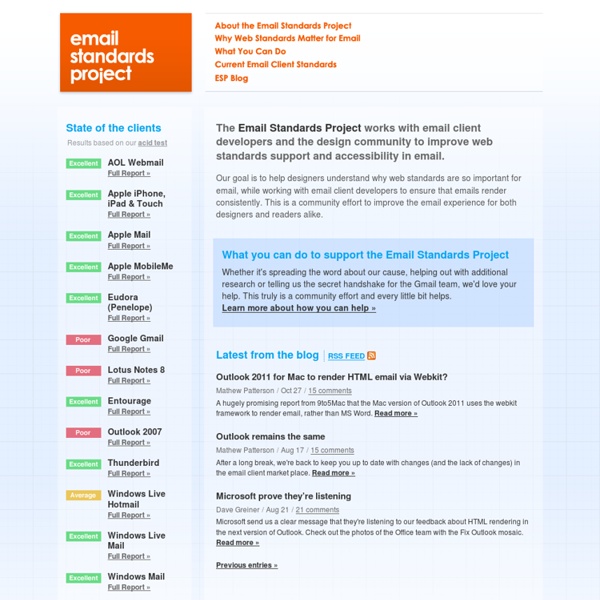



https://www.email-standards.org/
Airtight News I recently started playing with shaders in three.js and I wanted to share some of what I’ve discovered so far. Shaders are the ‘secret sauce’ of modern graphics programming and understanding them gives you a lot of extra graphical fire-power. For me the big obstacle to learning shaders was the lack of documentation or simple examples, so hopefully this post will be useful to others starting out. This post will focus on using pixel shaders to add post-processing effects to Three.js scenes. This post assumes you already know the basics of using Three.js. What is a Shader?
Blog - Litmus With an increased focus on mobile audience, many email marketers are scrambling to find a strategy that works for them. Unfortunately, there’s a lot of confusion about what mobile email design strategies actually exist. Don’t worry, though—we’re here to help clarify things. With over eight years experience as a web developer and a love for working with small teams, Kevin is the perfect addition to Litmus!
ResendingMailWithHeaders - Spamassassin Wiki Here's how to redirect (or "bounce") a mail message to another recipient. This is important when training Bayes via mail (as described in ProcmailToForwardMail), for example. It's often critical to redirect the message, rather than forwarding. Publications Email Insider Jimmy Wales On Wikipedia, Brands, Why He Loves Coke, But Doesn't Talk About It Question: Wikipedia plays a significant role in generating awareness and providing information for many brands -- particularly media and entertainment brands -- and yet, at this point in time, there is very little brands can do ... Internet Ad Revenue Hits $42.8 Billion In 2013, Surpasses Broadcast TV For the first time, marketers spent more to advertise on the Internet than they did for broadcast television in 2013. Investments in U.S. interactive advertising reached $42.8 billion in Internet advertising last year -- up 17% ...
Guide to CSS support in email clients (2008) Version history 14 November 2017 Outlook.com and the Outlook iOS app added support for CSS background images and some related properties, as well as certain Flexbox and Grid properties. Also added iOS 11 Mail to the guide, with no noticeable differences from iOS 10. 22 September 2017
How to optimize your email for mobile devices If your email subscriptions are anything like mine (as a fellow interactive marketer, I assume they might be), it seems like every other article that hits my inbox lately contains another new stat or case study regarding mobile. Whether we're talking about the mobile web, mobile apps, mobile email, or mobile sites, the "M-word" is everywhere. As more research regarding both the sales and usage of mobile devices -- specifically smartphones -- becomes available, many marketers are asking, "How should I be optimizing my email for mobile devices?"
Word 2007 HTML and CSS Rendering Capabilities in Outlook 2007 (Part 1 of 2) Summary: Learn about support for the HTML and Cascading Style Sheets specification provided by Word 2007 and Outlook 2007. Word 2007 HTML and CSS Rendering Capabilities in Outlook 2007 (Part 2 of 2) provides instructions to install and use the Outlook 2007 Tool: HTML and CSS Validator. (24 printed pages) Zeyad Rajabi, Microsoft Corporation A Guide to Creating Email Newsletters Email newsletters are hotter than ever. They’re a great extension to your business’ communication toolkit and offer you and your clients an excellent channel by which you can reach potential and existing customers. In this article, we’ll explore common design patterns of email newsletters and learn which approaches work well, so that you’ll be prepared to create one for yourself and your clients.
Advanced email marketing I’m pretty sure that my email inbox is going to drive me to the funny farm. It’s the only thing that I can never quite seem to get on top of. The other day, I received an email with the subject line, “Stress Management for Women.” Maybe they know something about me that I don’t, but I’m NOT a woman and I’m definitely NOT STRESSED!!! Ok, maybe just a little bit The point is, companies are turning to email marketing frequently because it’s cheap and it’s effective. 20 Email Design Best Practices and Resources for Beginners Even for experience designers, building email newsletters isn't easy. You receive a lovely looking design, and you crack on with the development. Unfortunately, it just doesn't work as it should in every email clients. Styles don't display, images aren't visible, etc. This is where these twenty best practices come in handy.